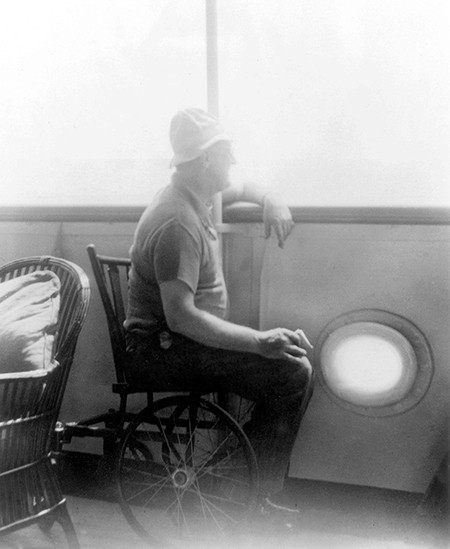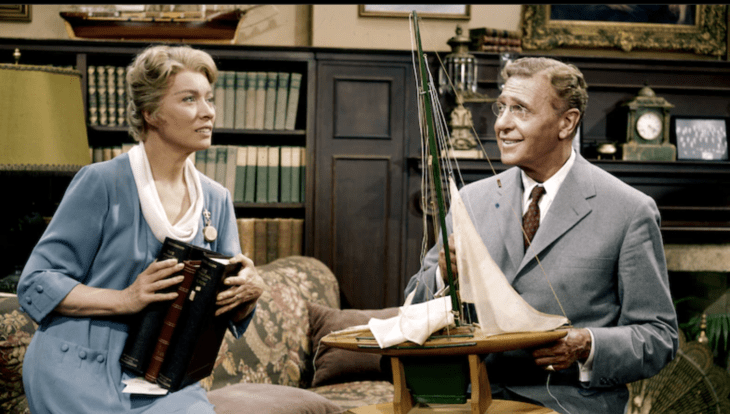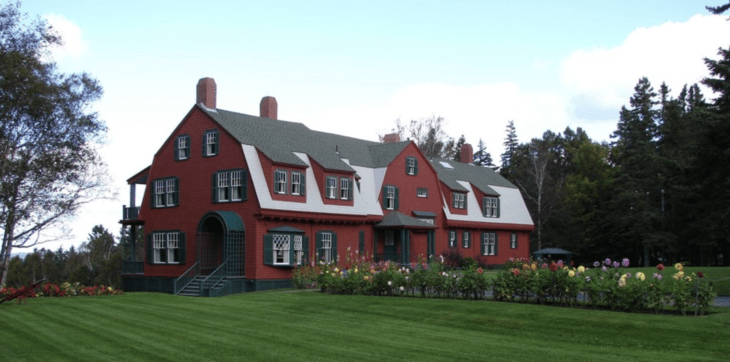
President Franklin Roosevelt sits in his wheelchair aboard the yacht Nourmahal in April of 1935.
You learn something new every day, and today we learned how future president Franklin D. Roosevelt got polio at age 39. Or how he probably got it: from the Boy Scouts.
Many of us have heard the Campobello Island part of this story: How FDR was at the family compound there, just off the coast of Maine, when he started to feel weak after falling off a boat into the icy Bay of Fundy. The next day he went sailing and swimming, helped put out a small forest fire, then lounged around in a wet bathing suit. Then he got sick.
This was back in 1921, when poliomyelitis (or infantile paralysis, as it was called) was rampaging. The Campobello stories always implied (or so we thought) that the cold water, the exertion, and the wet swimsuit somehow caused the polio. That never quite made sense — how does cold water cause polio? — but we just skipped over that part.
Now comes Michael Ruane of The Washington Post with a wonderful explainer on the whole incident, 100 years later. Ruane points out that you can’t get polio by being chilled; you actually have to ingest the virus by mouth. (The New York Health Department helpfully notes that “Polio is spread when the stool of an infected person is introduced into the mouth of another person through contaminated water or food.” Ugh.)
Which brings us to the heart of the matter. Roosevelt probably caught polio not at Campobello, but a few weeks earlier. Here’s Ruane, quoting Roosevelt biographer Geoffrey C. Ward:
On July 27, Roosevelt was part of a delegation of VIPs that visited an encampment of 2,100 Boy Scouts from New York City near Bear Mountain, about 40 miles north of the city. FDR was then, among other things, president of the Boy Scout Foundation of Greater New York. “There were parades and speeches,” Ward wrote of the encampment. FDR posed for pictures with crowds of scouts, and was toastmaster at a fried chicken dinner before returning to the city that evening.
“With him went a mysterious virus … perhaps … ingested at some point during the hot, hectic day … already moving through his bloodstream,” Ward wrote.
Yikes! A fried chicken dinner at an enormous camp-out with 2,100 dirty-handed boys: that sounds like a place where “contaminated water or food” might occur, yes. It was just about two weeks later, on August 10, when Roosevelt felt the chills and aching legs that signaled the onset of polio. Five weeks later, his condition was front page news in the New York Times.
The Boy Scout angle is speculation, of course. As the FDR Library points out, “No one is certain of the circumstances leading to his contraction of polio.” (They do agree that “many believe he was exposed to the virus at a Boy Scout camp in New York just prior to going to Campobello.”) It’s also quite possible that FDR’s fall into the bay and his other exertions lowered his resistance to the disease he already had. That part of the wet bathing suit story may actually make some sense. But it sounds like the Boy Scouts were the key culprit.
The whole Washington Post piece is well worth a read if you have any interest in the disease that changed the course of FDR’s life.

Or you can watch Sunrise at Campobello, the 1960 film with Ralph Bellamy as FDR and Greer Garson as his wife Eleanor. “In the summer of 1921, Franklin Delano Roosevelt spends carefree months at his summer home on Campobello Island in New Brunswick, Canada with his wife Eleanor and their five precocious children.” (Cue ominous music.)
This brings us to one other confusing point about the Campobello Island stories: They usually say that Roosevelt got polio at his “cottage” there. TCM, at least, calls it a “summer home,” but most insist on calling it a cottage. It sounds rustic, maybe like Calvin Coolidge‘s cozy li’l cabin at White Pine Camp in the Adirondacks.
Heh. Here’s what Franklin Roosevelt’s Campobello cottage actually looked like:

National Park Service photo
It’s beautiful! But… c’mon. That’s a Dutch Colonial mansion, with “34 rooms, including 18 bedrooms and six bathrooms.”) Let’s not kid ourselves with this cottage stuff.
To circle back to where we started: what a terrible disease polio was, and still would be if not for Jonas Salk and scientists like him. Thank heavens for their work — and thank heavens that everyone got the vaccine, which stopped polio in its tracks. Cases dropped by 85% in the first two years after widespread vaccination began. Thanks to steady vaccination of generations of children, no new case has originated in the United States since 1979. Vaccinations work!
Now see our full biography of Franklin D. Roosevelt »
